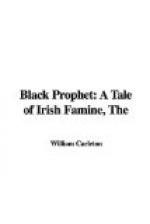In the mouth of this glen, not far from the cabin we have described, two murders had been committed about twenty years before the period of our narrative, within the lapse of a month. The one was that of a carman, and the other of a man named Sullivan, who also had been robbed, as it was supposed the carman had been, for the bodies of both had been made way with and were never found. This was evident—in the one case by the horse and cart of the carman remaining by the grey stone in question, on which the traces of blood were long visible; and in the other by the circumstance of Sullivan’s hat and part of his coat having been found near the cabin in question on the following day, in a field through which his path home lay, and in which was a pool of blood, where his foot-marks were deeply imprinted, as if in a struggle for life and death. For this latter murder a man named Dalton had been taken up, under circumstances of great suspicion, he having been the last person seen in the man’s company. Both had been drinking together in the market, a quarrel had originated between them about money matters, blows had been exchanged, and Dalton was heard to threaten him in very strong language. Nor was this all. He had been observed following or rather dogging him on his way home, and although the same road certainly led to the residence of both, yet when his words and manner were taken into consideration, added to the more positive proof that the footmarks left on the place of struggle exactly corresponded with his shoes, there could be little doubt that he was privy to Sullivan’s murder and disappearance, as well probably as to his robbery. At all events the glen was said to be haunted by Sullivan’s spirit, which was in the habit, according to report, of appearing near the place of murder, from whence he was seen to enter this chasm—a circumstance which, when taken in connection with its dark and lonely aspect, was calculated to impress upon the place the I reputation of being accursed, as the scene of crime and supernatural appearances. We remember having played in it when young, and the feeling we experienced was one of awe and terror, to which might be added, on contemplating the “dread repose” and solitude around us, an impression that we were removed hundreds of miles from the busy ongoings and noisy tumults of life, to which, as if seeking protection, we generally hastened with a strong sense of relief, after having tremblingly gratified our boyish curiosity.




